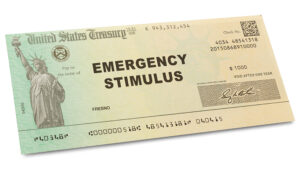You can still get your payments, but it may require filing taxes this year.

Millions of Americans have already received their third stimulus payment. However, millions more are wondering how to get their payment, particularly those who don’t file taxes. The good news is that you may still be eligible to receive the payment—you can also claim the other two if you haven’t received them already. The bad news is that you may need to file a 2020 tax return even if you don’t traditionally file.
This FAQ can help you understand how the system works and what you can do to claim any stimulus that you may be eligible to receive.
Stimulus FAQ
UPDATE: The IRS just announced on March 30 that payments to federal beneficiaries should be disbursed later this week. If you receive Social Security, disability, or VA benefits, you should receive your third stimulus payment the same way you receive your benefits. Direct Deposit recipients should receive payments within the next few days. If you receive your benefits by mail, it may take a few weeks.
On March 22, members of Congress wrote to the heads of the Internal Revenue Service (IRS) and Social Security Administration (SSA) to express concern over stimulus payment delays to beneficiaries. These delays extend to anyone who is set to receive their stimulus payment the same way they receive federal benefits. This includes Veterans who receive benefits through the U.S. Department of Veterans Affairs (VA) and Railroad Retirement Board Beneficiaries.
According to the American Rescue Plan Act, people who receive benefits through the SSA and VA should receive their third stimulus with no additional action needed. Benefits recipients would receive their third stimulus in the same way they receive their benefits.
However, payments for these groups have not started to go out thus far. What’s more, you will not be able to get information on the status through the IRS Get My Payment tool. And unfortunately, while the members of Congress asked for an update by Friday, March 26, no updates have been provided to the public as of yet.
In all the relief packages including the current 2021 American Rescue Plan Act, Congress tied stimulus payments to income. You are only eligible for an Economic Impact Payment (EIP) if your income falls below a certain level. That’s determined using your Adjusted Gross Income (AGI) or the annual income on your taxes once all deductions and credits are claimed.
Thus, if you don’t file taxes, the IRS (who is responsible for doling out payments) doesn’t know if you are eligible. There are plenty of people who don’t traditionally file taxes but who would still be eligible for an EIP:
- If you are single and have an AGI below $12,000 or married with a joint income below $24,000, you are not required to file
- Social Security beneficiaries
- Veteran’s benefit recipients
- Railroad retirees
If you’re in any one of these groups, then you may still be eligible. How you will get your third stimulus depends on which group you are in:
- For those that receive government benefits, like Social Security benefits, you should receive your new stimulus payment the same way you receive your benefits. Please see the question above to learn more about why your payment has been delayed.
- For those who don’t make enough to be required to file taxes, you may need to file your taxes this year to verify with the IRS that you are eligible to receive the payment. This is true even if you don’t traditionally file. You may be able to avoid this if you used the non-filers tool last year (see below)
- Of course, it also includes people who should have filed their taxes in the past few years but have not. We have guidance further down in this article if you fall into this group.
If you are in one of the groups that aren’t required to file taxes, then you may have already encountered an issue with the previous stimulus checks. For the first and second rounds of EIPs, the IRS created a tool for non-filers. You simply entered your name and Social Security number to determine your eligibility.
- For those who receive government benefits, through things like Social Security or the VA, your stimulus check would be sent via the same method you receive those benefits.
- If you were eligible but not a benefits recipient, then you could provide a bank account and routing number to get your stimulus check via direct deposit. You could also opt to receive a paper check by mail.
If you used this tool when it was available last year, then the IRS says it will distribute the new stimulus payment using the information you provided.
Be aware that if you did not use this tool last year, you will need to follow the instructions below.
To receive any first or second stimulus that you were eligible to receive but have not received yet, you must file a 2020 tax return to claim a Recovery Rebate Credit. This credit allows you to claim any full or partial stimulus that you’re entitled to receive.
Even if you are not typically required to file taxes, you must file this year to get the Recovery Rebate Credit. That’s the only way to get the stimulus that you are owed now. You can receive a rebate for all three stimulus payments.
If you’re not accustomed to filing, the IRS has a website that you can use to find free ways to file. For example, if you earn less than $72,000 annually, you can use Free File to file electronically through an IRS-approved provider. You will need to file for 1040 or 1040-SR to claim the Recovery Rebate Credit.
Yes, but you still must file your 2020 taxes. The IRS has stated that it will not garnish stimulus check payments for back taxes. Thus, you are legally entitled to the money if you meet the eligibility requirements.
It’s worth noting that the penalty for not filing your taxes is ten times the penalty for filing but failing to pay. So, even outside of stimulus, it’s generally in your best interest to file your taxes even if you can’t afford to pay back taxes that you owe. It will help you avoid having a small tax problem become a big problem quickly. Penalty interest on taxes compounds daily, so if you’re facing a penalty that’s ten times higher, the issue can grow quickly.
Be aware that the current Economic Impact Payment 3 is not protected from other types of garnishment. Private debt collectors can garnish your stimulus. State tax offices can also garnish it. But the IRS will not take your stimulus money, even if you owe them back taxes for this year or previous years.
No. According to the information that the IRS provides, you only need to file your 2020 tax return, which is the return for last year. The reason this return is important is that it provides a way for you to claim your Recovery Rebate Credit. That’s the money you’re rightfully owed from any of the three stimulus payments.
A single line on form 1040 or 1040-SR will tell the IRS how much money you calculate that you’re eligible to receive. However, to determine that number, you must complete a worksheet that walks through the steps that determine what that amount is.
As with any tax worksheet, it’s tedious. You can fill it out on your own or you can use one of the IRS’ free file providers. These types of systems help you file electronically and make it much easier to ensure you determined the amount accurately.
And, of course, you don’t get to just fill out that one line. You must complete the full form to file your 2020 taxes. It’s the only way to get any of the stimulus money that you’re owed.
